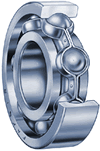|
The factors that determine the amount of
sliding friction between two hard surfaces are the
coefficient of friction and the normal force pushing the
surfaces together. By "hard surfaces" we mean those that
are deformed only a negligible amount when pushed
together. You can increase or decrease the amount of
resistive force of sliding friction by changing the
coefficient of sliding friction, by replacing it with
another type of friction or by changing the normal
force.
Questions you may have include:
-
How do you change the coefficient of
friction?
-
How do you replace the type of
friction?
-
How can you change the normal force?
Changing coefficient of friction
One way to increase or decrease the
force of friction from sliding two hard surfaces
together is to change the coefficient of friction
between the surfaces. The coefficient of friction is a
number between 0 (zero) and ∞ (infinity) and is a result
of the relationship between the surface roughness of the
two materials.
You can change the roughness of the
surfaces or even add a different material.
The relationship between friction and
its coefficient can be seen from the standard friction
equation:
Fr = μ*N
where
Fr is the resistive force of friction,
μ is the coefficient of friction for the
two surfaces (Greek letter "mu"), and
N is the normal or perpendicular force
pushing the two objects together.
Note that with the standard sliding
friction between hard surfaces, the area of the surfaces
is not a factor. In other words, large areas sliding
against each other will have the same friction as small
areas, provided the coefficients and normal forces are
the same.
One method to increase the coefficient of friction is to
make the surfaces rough or less smooth. A shoe sole that
contains a pattern of grooves or ripples will provide
much more friction when walking on slippery ice than
would a worn-out, smooth sole.
Polishing the surfaces that come into contact will
reduce the coefficient of friction between the surfaces
and thus reduce the amount of friction encountered. But
note that if you polish the surfaces to be extremely
smooth and flat, molecular effects may take place.
hen you slide two extremely flat and highly polished
metal surfaces together, molecular attraction adds to
the coefficient of friction. In other words, the
coefficient decreases as you reduce roughness up to a
certain point where it then increases due to the
molecular effects.
Once molecular effects come into play, the area of the
surfaces in contact are a factor in the friction. Thus,
the greater the area, the greater the friction caused by
molecular effects.
Some materials have a high coefficient of friction, not
because their surface is rough, but because the material
is "sticky" and molecular attraction adds to the common
coefficient of friction. Rubber is a good example of
molecular attraction adding to the standard coefficient
of friction caused by surface roughness.
Another method to increase friction by increasing the
coefficient is by using different materials that have a
higher value for the coefficient of friction. Materials
used in automobile brake pads do a much better job today
than the materials used in the early days of
automobiles.
Using material combinations that have a lower
coefficient of friction between them is another way to
reduce friction.
|
Coefficient of Friction |
|
Steel on steel (dry) |
0.6 |
0.4 |
|
Teflon on steel |
0.041 |
0.04 |
Coating a material with Teflon will greatly reduce the
friction
Replacing type of friction
Although reducing the coefficient of friction is a
method to decrease the force of friction, it has its
limitations. For example, you can only polish a material
so much until the coefficient actually increases due to
molecular effects. A better way to reduce the
coefficient of sliding friction is to eliminate it
altogether by replacing it with rolling friction and/or
fluid friction.
Rolling friction
Instead of sliding surfaces together, you can add
rollers between the surfaces, thus changing over to
rolling friction.
When making the Great Pyramids, the ancient Egyptians
had great difficulty sliding the huge granite slabs to
the pyramid site. So they reduced the friction by
rolling the slabs on logs.
By adding a thin layer of oil or even water between two
objects, you convert the sliding friction to fluid
friction. This lubrication is used in many applications
to reduce wear and to make the sliding much easier.
|
Coefficient of Friction |
|
Steel on steel (dry) |
0.6 |
0.4 |
|
Steel on steel (grease) |
0.1 |
0.05 |
Adding grease as a lubricant reduces the coefficient of
friction
In some situations, adding a lubricant actually
increases the friction, due to molecular effects. For
example, a coin will slide down a plastic ramp. But if
you wet the ramp, the coin will stick in one place. You
might think the water would be a lubricant, but for
small objects, its molecular force is stronger than the
gravitational pull on the object.
Another example is trying to use a heavy, thick oil or
grease as a lubricant. The friction may be much great
than if you used a light oil or even no lubricant at
all.
The axles in a bicycle, automobile and other devices
used to rotate in a hub, sliding metal against metal.
Soon a lubricant was added to reduce the friction. But
then a set of ball bearings was inserted between the
axle and hub to change the friction to rolling friction.
The ball bearings, along with lubricating oil, greatly
reduce the friction in rotating a wheel.

Ball bearings reduce axle friction
Changing normal force
The normal force, N, is the perpendicular force pushing
the surfaces together. By increasing N, you increase the
resistive force of friction. Decreasing N, lowers the
friction.
Note that changing friction by changing the normal force
also applies to situations where you have included
lubrication or rolling friction.
The force clamping automobile brake pads to the brake
disk determines the friction used to slow down the car.
Of course, releasing the brakes causes N to become zero,
resulting in no friction force.
When you step on the brakes in your car, the brake
calipers clamp onto metal disks that are part of your
disc brake system. The friction between the caliper and
the disk is sufficient to slow down and stop your
wheels. That is where the tires take over. Their
friction on the road then stops your car from moving.
If the normal force is the weight of objects you are
sliding across the floor, adding or subtracting weight
will increase or decrease the sliding friction. But
also, if you are pulling an object with a rope, pulling
at an upward angle will reduce the normal force.

Reducing normal force by pulling at an upward angle
In conclusion
Coefficient of friction and the normal force pushing the
surfaces together are the factors that determine the
amount of sliding friction between two hard surfaces.
You can increase or decrease the amount of resistive
force of sliding friction by changing the coefficient of
sliding friction, by replacing it with another type of
friction or by changing the normal force. |